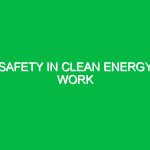As the world increasingly turns to renewable energy sources, solar power has emerged as a popular choice for both residential and commercial applications. The allure of harnessing the sun’s energy is compelling, but it is crucial to recognize the hazards associated with solar panel installation and maintenance. Understanding these risks is essential for ensuring health, safety, and environmental (HSE) compliance. This article will delve into the multifaceted hazards presented by solar panel systems, offering insights into safety precautions, best practices, and relevant regulations.
The Relevance of HSE in Solar Panel Installation
Health, Safety, and Environment (HSE) protocols are critical in the solar industry. From the initial installation to ongoing maintenance, workers are exposed to various risks that can lead to injuries, health complications, or environmental damage. The integration of HSE practices helps mitigate these risks, ensuring a safer working environment and promoting sustainable practices.
Potential Hazards Associated with Solar Panel Installation and Maintenance
When discussing the hazards associated with solar panel installation and maintenance, it is essential to recognize the diverse range of risks involved. These can be broadly categorized into physical, electrical, chemical, and environmental hazards.
1. Physical Hazards
Physical hazards are prevalent during the installation process. Workers often operate at significant heights, such as rooftops, which poses the risk of falls. According to the Occupational Safety and Health Administration (OSHA), falls are one of the leading causes of fatalities in construction. Proper ladder safety, harnesses, and guardrails are crucial in preventing such accidents.
Additionally, handling heavy solar panels can lead to musculoskeletal injuries. Workers must employ proper lifting techniques and utilize equipment like dollies and hoists to mitigate these risks. A personal anecdote shared by a solar installer highlighted how a lack of awareness regarding lifting techniques resulted in a back injury that sidelined him for weeks—a stark reminder of the importance of training and vigilance in physical safety.
2. Electrical Hazards
Solar panels generate electricity, and with that comes the inherent risk of electrical shock or arc flash incidents. Technicians must be trained to understand the electrical systems involved, including direct current (DC) and alternating current (AC) systems. Proper lockout/tagout (LOTO) procedures must be followed to ensure that systems are de-energized before maintenance work begins. In one case, a technician experienced a severe shock while attempting to repair a malfunctioning inverter, underscoring the crucial need for safety training and adherence to electrical safety protocols.
3. Chemical Hazards
Solar panels and their components may contain hazardous materials such as cadmium, lead, and silicon dust. Exposure to these substances can pose health risks, including respiratory issues, skin irritation, or more severe long-term health problems. It is vital for workers to use appropriate personal protective equipment (PPE), such as gloves, goggles, and respirators, when handling solar panels or performing maintenance tasks. A story shared by an environmental health expert emphasizes the importance of proper disposal and recycling of solar panels to minimize chemical exposure and environmental impact.
4. Environmental Hazards
Environmental hazards can also arise during installation and maintenance. Soil erosion, habitat destruction, and water contamination are potential risks associated with improper site management. During the installation of solar farms, it is essential to conduct environmental assessments to identify sensitive areas and implement measures to protect local ecosystems. A notable case involved a solar project that unintentionally disrupted a nearby wetland, leading to significant ecological repercussions. Such incidents highlight the importance of thorough planning and environmental stewardship in solar projects.
Safety Precautions and Best Practices
To mitigate the risks associated with solar panel installation and maintenance, implementing comprehensive safety measures is imperative. Below are some actionable practices that can enhance safety in the field:
1. Training and Education
Regular training sessions should be conducted for all workers involved in solar panel installation and maintenance. This training should encompass fall protection, electrical safety, handling hazardous materials, and environmental awareness. Incorporating real-life scenarios and case studies into training can significantly enhance understanding and retention of safety protocols.
2. Use of Personal Protective Equipment (PPE)
Employing the right PPE is vital in protecting workers from physical and chemical hazards. Hard hats, safety glasses, gloves, and fall protection gear should be mandatory on job sites. Moreover, ensuring that all PPE meets regulatory standards is essential for effective protection.
3. Implementing Safety Protocols
Establishing clear safety protocols, including LOTO procedures and emergency response plans, can significantly reduce risks. Regular safety audits and inspections should be conducted to ensure compliance with these protocols. A well-documented incident response plan can also prepare workers for unexpected situations, minimizing the potential for injuries.
4. Environmental Considerations
Before beginning any solar project by working with vendors like Renewture solar in Lake Macquarie, conducting thorough environmental assessments is crucial. This includes evaluating potential impacts on local wildlife and ecosystems. Implementing site-specific management plans can help mitigate adverse effects and promote sustainability. Best practices also include proper recycling and disposal methods for old or damaged solar panels to prevent environmental contamination.
Regulations and Standards Governing Solar Panel Safety
Various regulations and standards govern the installation and maintenance of solar panels, aiming to ensure the safety of workers and the environment. In the United States, OSHA provides guidelines that cover fall protection, electrical safety, and hazard communication, among others. Additionally, the National Electrical Code (NEC) sets standards for electrical installations, including solar energy systems.
Internationally, organizations such as the International Electrotechnical Commission (IEC) establish standards for solar energy technologies, promoting safety and efficacy in the industry. Familiarity with these regulations is essential for compliance and to foster a culture of safety in solar projects.
Conclusion
The hazards associated with solar panel installation and maintenance are numerous and varied, encompassing physical, electrical, chemical, and environmental risks. By prioritizing HSE protocols, implementing best practices, and adhering to relevant regulations, the solar industry can create a safer working environment for its employees while promoting sustainable energy solutions. As the push for renewable energy continues to grow, understanding and addressing these hazards will be paramount in ensuring the industry’s success and safety. A commitment to continuous education, safety training, and environmental stewardship will not only protect workers but also contribute to the broader goal of sustainable energy for future generations.


